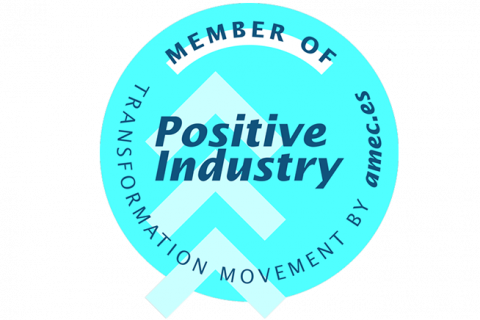
-
Company
-
We talk your language
TMI is your partner for bagging, palletizing and stretch-wapping systems.
- About us
- Talented people
- News
-
-
Solutions
-
Complete bagging lines
TMI manufactures complete bagging lines: from the dosing of the finished product to the protection of the load. We supply bagging machines, palletizers and stretch-wrapping systems that suit your needs. Browse through our portfolio and find the optimal solution for your end of line.
- Bagging systems
- Bag palletizing systems
- Pallet stretch-wrapping
- Industry 4.0
-
-
Industries
-
Solutions that fit your project
We develop bagging and palletizing solutions for different industries. Choose yours to see the solutions that best suit your needs.
- Food
- Agri-food
- Chemicals & petrochemicals
- Construction & mining
- Recycling
-
- Services
- Contact
- Ask for a quotation
-
Company
-
We talk your language
TMI is your partner for bagging, palletizing and stretch-wapping systems.
-
-
Solutions
-
Complete bagging lines
TMI manufactures complete bagging lines: from the dosing of the finished product to the protection of the load. We supply bagging machines, palletizers and stretch-wrapping systems that suit your needs. Browse through our portfolio and find the optimal solution for your end of line.
-
-
Industries
-
Solutions that fit your project
We develop bagging and palletizing solutions for different industries. Choose yours to see the solutions that best suit your needs.
-
- Services
- Contact
DECHKOV MILL – WHERE END-OF-LINE AUTOMATION STANDS FOR OPTIMAL PRODUCTIVITY
July 01, 2022
TMI, in partnership with its local partner Avesto Ltd., has provided this Bulgarian wheat milling company with a complete bagging line solution, which has directly impacted its productivity. Want to know how? Keep reading!
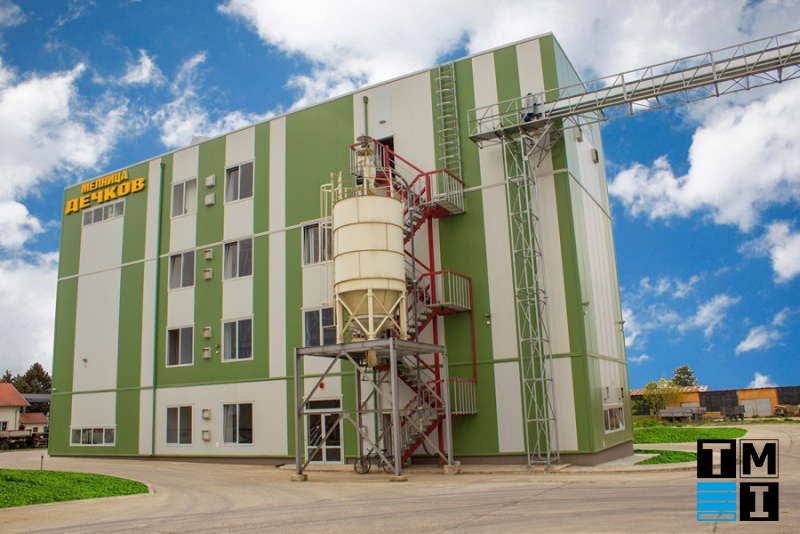
ABOUT THE COMPANY
Melnitza Dechkov Ltd. is a mill that produces and sells wheat flour and wheat bran. Located in the Pleven region, which is known in Bulgaria for growing quality cereals, the company has built two mills with a total capacity of 150 tons/day: the first in 2001 and the second in 2011, as a direct consequence of growing demand.
Dechkov defines itself as a long-term, reliable, honest partner for its suppliers and clients.
The mill line is equipped with highly efficient machines for cleaning and preparing the wheat, which guarantees the quality of the final milled product. Automation at various points of the production process means that different types of flours can be made, as well as special flours following clients’ specifications.
The finished flours and bran are then shipped in bulk, in packs weighing 1 kg, 5 kg, 10 kg, 25 kg and/or 50 kg, depending on the product type. Yet, until now, the packaging line was not automated.
We met with Vladislav Dechkov, CEO of Melnitza Dechkov Ltd., who talked to us about their end-of-line automation project and its development with TMI and Avesto.
THEIR NEEDS
After automating the production process, the next logical step for Dechkov Mill was to automate the end of the line, i.e. bagging and palletising. So, they started to work on identifying their main needs in this area: reduced costs, increased productivity and improved packaging quality.
They also had to define the scope of the project, which was finalised as follows: they were looking for a bagging machine and a palletising machine able to bag the product into valve bags in a wide range of formats (5, 10, 25 and 50 kg) while protecting the food product.
With these goals in mind they started looking for possibilities, though it was not an easy ride, as Mr. Dechkov explains: ‘The main difficulty was the lack of information; there was nowhere in Bulgaria where we were able to see a working line like the one we needed’.
So, they contacted Avesto Ltd. to seek some advice on this project and find a solution for their end of line.
ABOUT AVESTO AND TMI
Avesto Ltd. is an engineering company established in 2005 that represents leading international industrial companies and provides different types of equipment, installation services, consumables and spare parts all over Bulgaria.
As a trusted partner of TMI, Avesto offers the whole range of TMI products, which are widely used in three sectors of the country’s industrial structure: agriculture, mining and processing. As soon as the product is ready to be packed, TMI can offer bagging solutions for all sorts of products with different behaviours, palletising solutions for various types of bags and speed requirements, and pallet protection with film using stretch-wrapping technology.
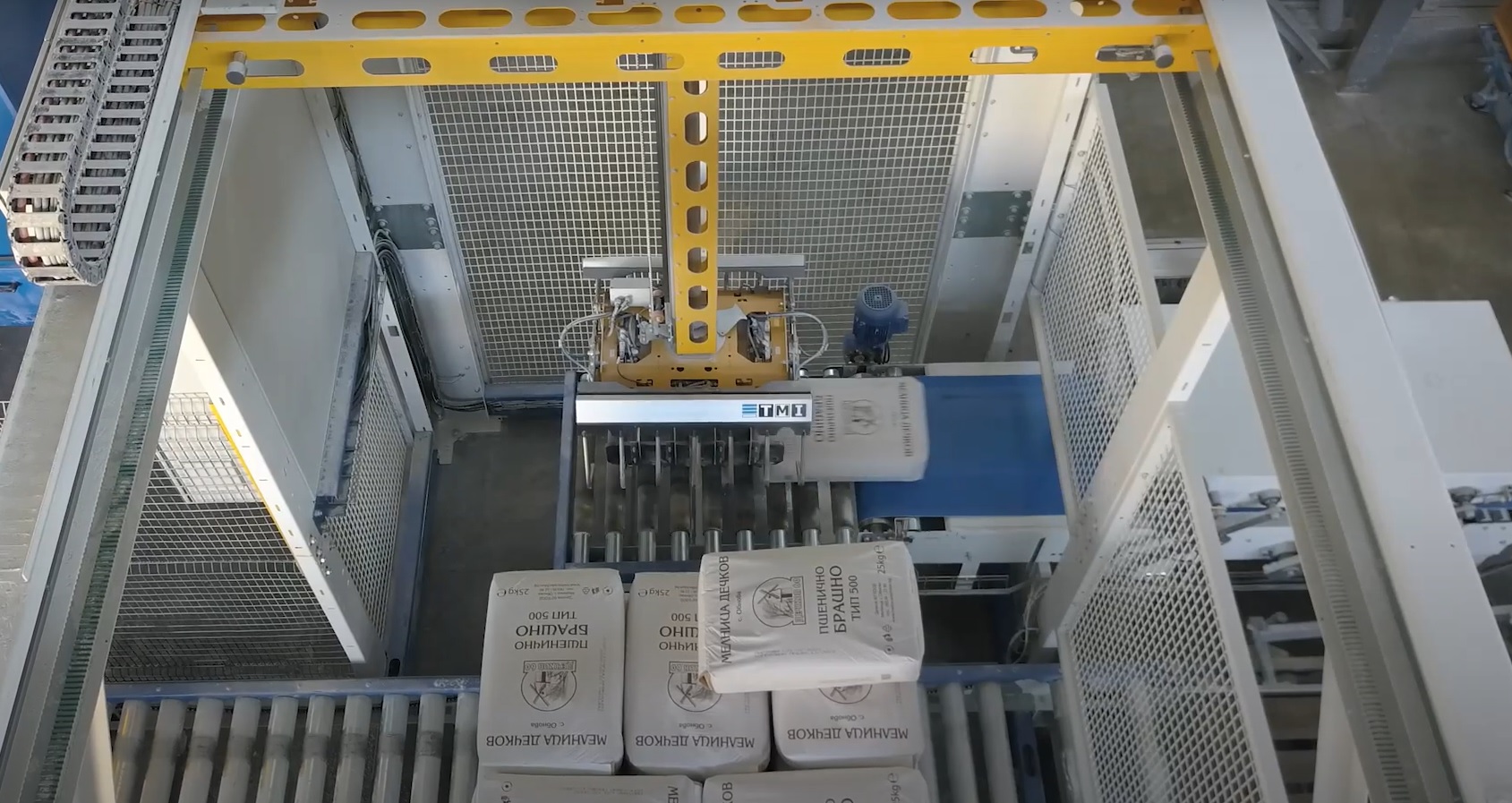
THE PROPOSED SOLUTION
With their joint experience and expertise, Avesto and TMI found a solution to suit Dechkov’s requirements perfectly, and so they proposed the following:
-
ILERSAC VBF: an automatic bagging machine for valve bags, which includes an ILERSONIC ultrasonic sealing system to protect the product from external agents. It can also adapt to bags of very different formats, as the bagging spout can easily be changed according to the diameter of the bag valve.
-
ILERPAL P: an automatic gantry palletiser, which is very compact and cost-effective while offering great palletising results and completely stable loads.
This solution was a perfect fit for the customer’s needs and requirements, so they chose Avesto’s proposal: ‘Only Avesto suggested a machine able to pack 5 kg, 10 kg, 25 kg and 50 kg in valve bags. Also, the price and the capacity of the machine were what we were looking for’, says Mr Dechkov.
You can see this line in action in this video.
THE RESULTS
This bagging line was manufactured in Spain and then delivered to Bulgaria. Commissioning and start-up were carried out by a team made up of TMI and Avesto technicians. The Avesto technicians worked on site, while TMI technicians were able to assist them remotely using a Tele-service device. This way, the budget was kept under control, as no international travel was required from technicians.
You can see the result in this video, where the complete bagging line is working.
According to Mr Dechkov, the bagging and palletising line has directly contributed towards increasing the plant’s productivity and improving packaging quality: ‘We started to pack more bags per hour with fewer people. For example, with our old machine, we packed 3.5 tons of 25 kg per hour with 2 people, and now we pack 5 tons of 25 kg with 1 person’.
The prospects for future growth have also improved for this Bulgarian company: ‘We think we will be more flexible and ready for new challenges in the market’, concludes Mr Dechkov.
ALWAYS AT THE CLIENT’S SIDE
Do you want to know how TMI’s solutions can contribute towards improving production and efficiency in your plant? Just get in touch with us and we will advise you on packaging.
You can also check our worldwide partner network to find our local partner in your area.
ABOUT HYGIENIC DESIGN AND HOW WE APPLY IT TO BAGGING MACHINERY
May 27, 2021
Find out about the basic principles of hygienic design and how we apply them to TMI bagging solutions.
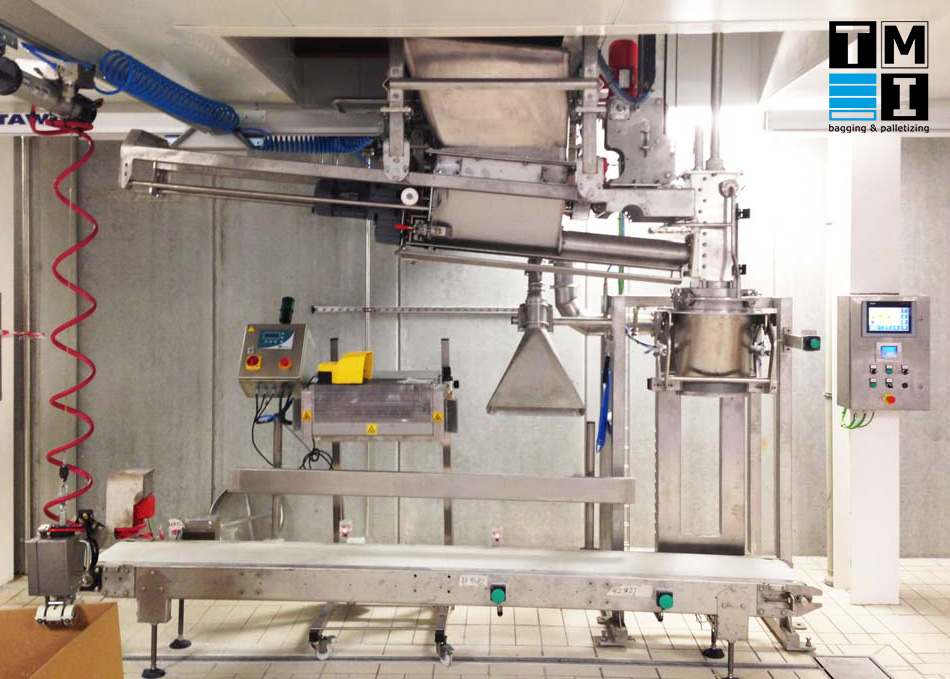
Food producers have an important and unavoidable mission: to guarantee the safety and traceability of their products at all stages of the chain, from the production of each ingredient until the final product is consumed.
To this end, there are various food safety regulations that define, among other things, the requirements to be met by equipment and facilities that may be in contact with foodstuffs. These regulations not only constitute the legal framework that producers must comply with, but also define what is known as hygienic design.
In this article you can find out about the basic principles of hygienic design and its importance in the food industry:
WHAT DOES HYGIENIC DESIGN STAND FOR?
Hygienic design is of major concern in plant and equipment construction, being the systematic focus of the food industry, where ensuring the safety and health of consumers is of paramount importance.
The aim is therefore to eliminate sources of physical, chemical or microbiological contamination of foodstuffs. This is a risk that must be avoided at all costs, and this is achieved by minimising any possible source of contamination, making it visible at all times, and making it easy to clean.
REGULATION OF HYGIENIC DESIGN
In order to ensure the necessary hygienic production conditions, regulations have been established, differing from country to country, which define the criteria to be followed and the measures to be taken in the design of safe equipment and facilities.
In the European Union, the legal framework that defines it is the Machinery Directive 2006/42/EC, together with Regulation (EC)1935/2004 on materials and articles used in contact with foodstuffs, European hygiene legislation and the legislation of the individual member states. In addition, the non-statutory standards ISO 14159 and EN 1672-2 have to be taken into account. These standards define requirements for materials, surfaces, joints, liquid drainage, contamination and cleanability.
Additionally, there is the fundamental role of the EHEDG (European Hygienic Engineering and Design Group), which is the body that assists European legislators, defines and spreads hygienic design standards and provides certification of equipment.
Beyond the EU, there are also other reference regulations: in the USA there are the sanitary standards 3-A, the NSF (National Sanitary Foundation), the FDA (Food & Drug Administration), the GMP (Good Manufacturing Practice) and the HACCP (Hazard Analysis and Critical Control Points); in the UK, there is the BRC (British Retail Consortium).
The norms and guidelines established by all these bodies and systems give rise to what is known as hygienic design, which aims to fulfil the requirements set by them.
Some directives provide for certification of the hygienic design and issuing of certificates if the hygienic design guidelines are met and the prescribed hygiene tests are successfully passed.
BASIC GUIDELINES OF HYGIENIC DESIGN
Basic premises of hygienic design are: to avoid dirt accumulations on all surfaces, making them visible and inspectable, to ensure that cleaning can be carried out easily and to keep the production environment in good condition so as not to constitute a potential contamination source (including the floor of the facility).
Hygienic design concerns the definition of materials, processes, surface treatment, joining techniques and the morphology of the parts themselves in order to ensure the proper construction of the machines to be installed in food production lines and all their components.
Therefore, the following criteria are defined as the basis for hygienic design:
- CLEANING AND SANITIZING: It must be possible to clean the installations, machinery, or surfaces in an adequate manner, eliminating the remains of dirt that can cause the growth of micro-organisms. For this purpose, they must be designed to allow easy cleaning access.
- ACCESSIBILITY: the installation should be easily and tool-free disassembled to ensure access to all areas requiring hygiene, whenever possible and especially when wet cleaning, in which case it should also allow for easy drainage of liquids.
- SURFACES: must be resistant to corrosion generated by the hygiene processes and food itself, while avoiding, as far as possible, the use of surface coatings that could be a source of contamination. They should therefore be smooth, minimising roughness, and dead spots should be avoided. Therefore, they should not contain joints or fissures where leftovers can accumulate, so appropriate welding techniques should be applied for this purpose.
- MATERIALS: The choice of materials is key in the design. Priority is given to materials that are corrosion resistant, non-toxic, easy to clean and prevent the growth of micro-organisms. Stainless steel is generally considered to be the best choice, although corrosion may occur in chemically aggressive environments (e.g. when using cleaning products containing chlorides). For these cases, it is recommended to use FDA and/or 10/2011/EU compliant plastics that are suitable for food contact. The use of metal-detectable plastics is also recommended.
Given all these criteria, it is important to distinguish between surfaces that come into contact with the product and those that do not, for a right assessment on the risk and the hygienic design to adopt in each area.
ADVANTAGES OF HYGIENIC DESIGN
Producers who build their facilities including the hygienic design concept into the plant and into their equipment, achieve:
- FOOD SAFETY: the main purpose is to ensure hygienic production conditions, thus making it easier for food producers to comply with safety regulations and to ensure consumer safety.
- COST REDUCTION: In all production facilities, downtime for cleaning reduces production efficiency and increases costs (labour, energy and quality control). In the case of hygienic design, although it involves a higher investment in the purchase of the equipment, in the long term the TCO (Total Cost of Ownership) is comparatively lower. This is due to reduced cleaning times, energy consumption, personnel costs, together with increased compliance with guidelines and regulations, which results in greater safety for the consumer.
- REDUCED ENVIRONMENTAL IMPACT: The hygienic design, which aims to optimise the sanitising process, allows for a reduction in energy, water and cleaning product consumption.
APPLICATION ON BAGGING LINES
TMI has designed and manufactured many bagging, palletising and stretch wrapping lines for the food industry worldwide, which have included hygienic design in their conception. With the aim of supporting food producers, we have developed solutions that contribute to the following improvements:
EASY CLEANING AND MAINTENANCE
In the bagging process there is one key point where surfaces are of vital importance for food safety: dosing. Here the surfaces are in full contact with the product, and it’s vital that the cleaning can be carried out easily, quickly and thoroughly.
For this purpose, TMI has designed a series of applications that improve maintenance throughout the product dosing units:
-
- Dismountable dosing units: Whether belt or auger dosing units, they can be completely dismantled without the use of tools. This allows operators to carry out a thorough cleaning and inspection quickly and efficiently.
- Automatic water cleaning cycles: Using sprayballs, waterproof connections to water collection systems and air-drying systems, it is possible to initiate automatic water washing cycles from the PLC of the bagging machine itself, optimising cleaning times to the maximum.
- Inclined augers: they allow easy draining of all liquids used in the cleaning cycles.
- No corners: all dosing units are designed to be free of corners where product could accumulate, with open and visible edges, watertight welded joints and no horizontal edges at all.
CLEAN AND SAFE FACILITIES
Beyond dosing, there are many other factors and points in the bagging line where hygienic design is key to ensuring safe food products for consumption:
-
- Materials: TMI can adapt the materials of construction of its bagging machines to the customer's requirements and washing methodologies. Our bagging machines can be built in stainless steel, partially or completely, and FDA-compliant plastic materials are also used for those elements that for technical reasons cannot be made of steel (e.g. flexible product discharge tubes, telescopic bagging spouts, or mesh conveyor belts).
- Minimising product build-up: flat surfaces are one of the main places where product remains or residual dust accumulate and can become a breeding ground for micro-organisms. To prevent proliferation, TMI applies the EHEDG criteria to hygienic constructions, e.g. with the diamond shape construction, which prevents any build-up due to the edge angles. The contact surfaces between components are also reduced to the essential minimum, including the wiring, which is installed along cable guides for easy access and cleaning without the need for removal, giving priority to a vertical rather than a horizontal position.
- Easy cleaning of the line surroundings: the bagging machines, as well as all bag and pallet conveyors, are fitted with as few floor supports as possible, thus facilitating good hygiene in the immediate area around the bagging line. Moreover, the support legs can be cylindrical and/or made of stainless steel.
- Separate electrical cabinets: placing the electrical cabinet in another room allows water washing cycles to be carried out while preserving the safety of the room where the bagging machine is located. It also enables maximum hygiene to be maintained in cases where the bagging machine is located in a clean room. The cabinets can be equipped with different degrees of IP protection and/or inclination of the upper part of the cabinets, if required by the customer.
TRACEABILITY
Beyond directive definitions and the concept of hygienic design, in many cases it is also considered necessary to integrate metal detection systems along the line, as well as checkweighers, to always ensure the safety of the packaged product. These detection systems can be connected to alarms that instantly notify operators, as well as to data collection systems, so that the manufacturer can have actual data on the conformity of the units produced.
SOME EXAMPLES
Such solutions have been incorporated, among others, in the design of the ILERBAG HC, a tubular FFS bagging machine designed for industries requiring a high level of hygiene; also in the construction of an auger net weight dosing system for glucose for pharmaceutical use; another example is TMI's latest development: the ILERBAG V for the food industry, a VFFS bagging machine that has been designed based on the requirements of sugar and chocolate producers.
DESIGN THE HYGIENIC END OF LINE YOU NEED
At TMI we are aware that each project has its own specific requirements. Therefore, we assess the hygiene requirements of each individual project and propose solutions that meet them. If you want further information about the solutions that TMI can offer for your project, please contact us by filling in the quotation form: we will help you!
MOULIN DESGUÉS – A PALLETIZATION AUTOMATION SUCCESS STORY
December 28, 2021
Moulin Desgués is an independent, family-run mill founded in 1891 that produces premium flour for the region’s artisanal bakeries and strives to use technology to maximize quality. We talked to Nicolas Desgués about his experience with the TMI bagging line installed at the mill.
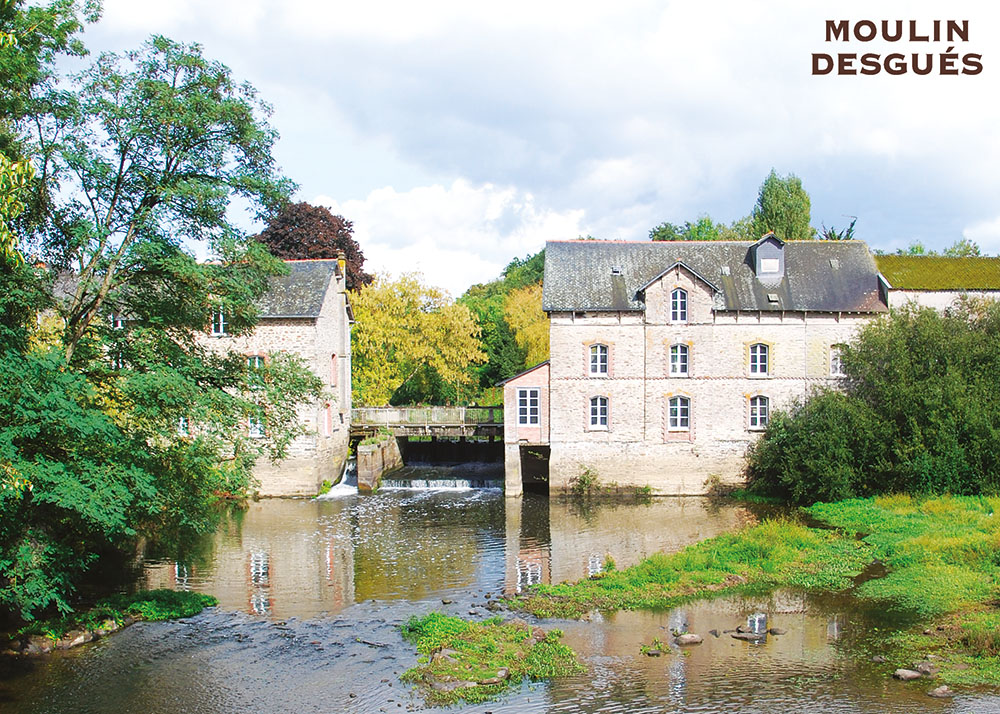
ABOUT THE COMPANY
Moulin Desgués was born in 1891 when Philidor Desgués became a miller at Bazoges Mill. In 1949, the family acquired Acigné Mill, in Brittany, France, and named it Moulin Desgués. This is where the company’s production would take place. The company, directed by David and Nicolas Desgués, is still an independent, family-run business today.
Its main activity is the production of flour for artisanal bakeries in France, which they deliver exclusively within a radius of 200 km. Proximity to the customer is one of the three pillars of the company’s values. The other two are premium quality and the origin of the wheat, which is always 100% French.
Indeed, the business aims to produce flour of a higher quality than was ever possible before. Thanks to these efforts, Moulin Desgués flour has been awarded LABEL ROUGE certification. To maintain this label, the company undergoes yearly audits and the quality of its flours is analysed on a very regular basis.
THEIR NEEDS
Previously, flour sales consisted of 50% bags and 50% bulk, as was the standard in the industry. But for around five years now, the trend has evolved considerably, leading to a ratio of 80:20 in favour of bags. The main reason for this is that bakers are less and less willing to invest time and effort in maintaining flour silos, when they can simply buy a bagged product that offers the same return.
As a result, almost all flour today is sold in 25 kg bags, which requires palletization of the packaged product.
Moulin Desgués already had a TMI ILERFIL ANS manual bagging machine, with net weight dosage and an auger, which was installed in 2014. However, all palletization was done by hand, which was time-consuming and onerous for employees, due to growing demand for bags. To help them along, the need for an automatic palletizer was identified.
WHY TMI?
Nicolas Desgués defined his end-of-line needs precisely and got in touch with TMI: the company that made and installed the bagging machine with which he is still very satisfied. He says, ‘I bumped into Gerard Martinez, TMI’S salesperson, at the Vrac Tech Trade Show in Le Mans. I’ve known him since we got our bagging machine installed. We talked about my new palletizing project’.
THE TMI SOLUTION
Our technicians analysed the client’s needs, the space available, and the production and working conditions, and concluded that the most suitable solution for Moulin Desgués was the ILERPAL P: a gantry-type Cartesian bag palletizer with robotic gripper that can palletize up to 420 bags per hour. This is a simple installation that guarantees high precision. As well as being robust and cost-effective, the ILERPAL P is a compact machine, so it fits easily on a business’s premises, even in a tight space. It can palletize bags from 5 to 50 kg and offers flexibility and speed when it comes to bag changes.
First of all, we proposed a new ILERPAL P palletizer to Moulin Desgués, as is the norm for TMI, as our main activity is manufacturing machines. But just at that time, a TMI client in Spain decided to increase their production capacity with an ILERPAL H palletizer, and put their existing ILERPAL P up for sale.
As it had a similar configuration to the one Moulin Desgués needed, TMI spotted a great opportunity for the client and let them know. Nicolas Desgués tells us more: ‘First, we received a proposal for a new ILERPAL P palletizer, then we were offered the same model second hand. It was a great deal, because the palletizer was very new and in perfect condition’.
PROJECT EXECUTION
The palletizer sold by the Spanish client was used for seeds and needed some modifications. Moulin Desgués was notified that this would take some time, but much less than making a new machine would take.
Some adjustments also needed to be made to the mill, before the palletizer could be installed: ‘We needed to raise the floor level where the palletizer was going to be in case of flooding’.
Meanwhile, TMI adapted the machine configuration to the client’s bags, and it became clear that not all bag formats would work: some made the pallet unstable for transport. The client explains:
‘During testing in the TMI factory, we were told that the shortest bags were causing problems. And it was true: we saw that we needed to change the bag format for the pallet to be stable and arrive at its destination without a hitch’.
We therefore adapted and standardized the bag measurements, ensuring better stability with bags of the same length to make sure the pallets stay secure during transport.
When the palletizer was ready to be installed on the client’s premises, the TMI after-sales department technicians picked up the baton. According to Nicolas Desgués, the installation process went smoothly: ‘We got on well with the TMI technicians, who were very professional. They listened to our needs and agreed to make a few small modifications on site. The training was really suited to our use of the machine. The technicians took their time to explain how to use the palletizer in an optimal way’.
IN ACTION
The complete bagging and palletization line has been in action for four months now at Moulin Desgués. This is not much when compared to a machine’s total useful life, but the results seen by the client are already excellent: ‘It is exactly what we were expecting, and above all, we are relieved not to have to put the pallets together by hand any more. We have adjusted some of the palletizing pattern settings, like the TMI technician taught us’.
As well as a significant reduction in health and safety risk on the premises, as ‘less pressure is put on the joints and the back’, the client is seeing an optimized work process and a serious productivity boost: ‘This saves us a lot of time: now, just one person can do this work, whereas two were needed before. This frees up time to do other things within the business’.
ALWAYS AT THE CLIENT’S SIDE
One of TMI’s core values is to accompany the client throughout the journey of defining their bagging line project and in the decision-making process. Here, TMI identified an excellent opportunity for the client and provided the technical support needed to successfully install a palletizer that fully meets their expectations and fulfils their needs.
Want to know how TMI can help to improve your production line’s productivity? Contact us through this form for advice adapted to your needs!
TMI LAUNCHES THE NEW ILERBAG HC: FFS BAGGING MACHINE WITH A CLEAN DESIGN
May 15, 2020
The experience and know-how that TMI has gained in the food industry, together with the previous experience of the customer, have led to developing a bagging machine that is highly accurate and efficient in the hygiene processes that are essential to food industry.
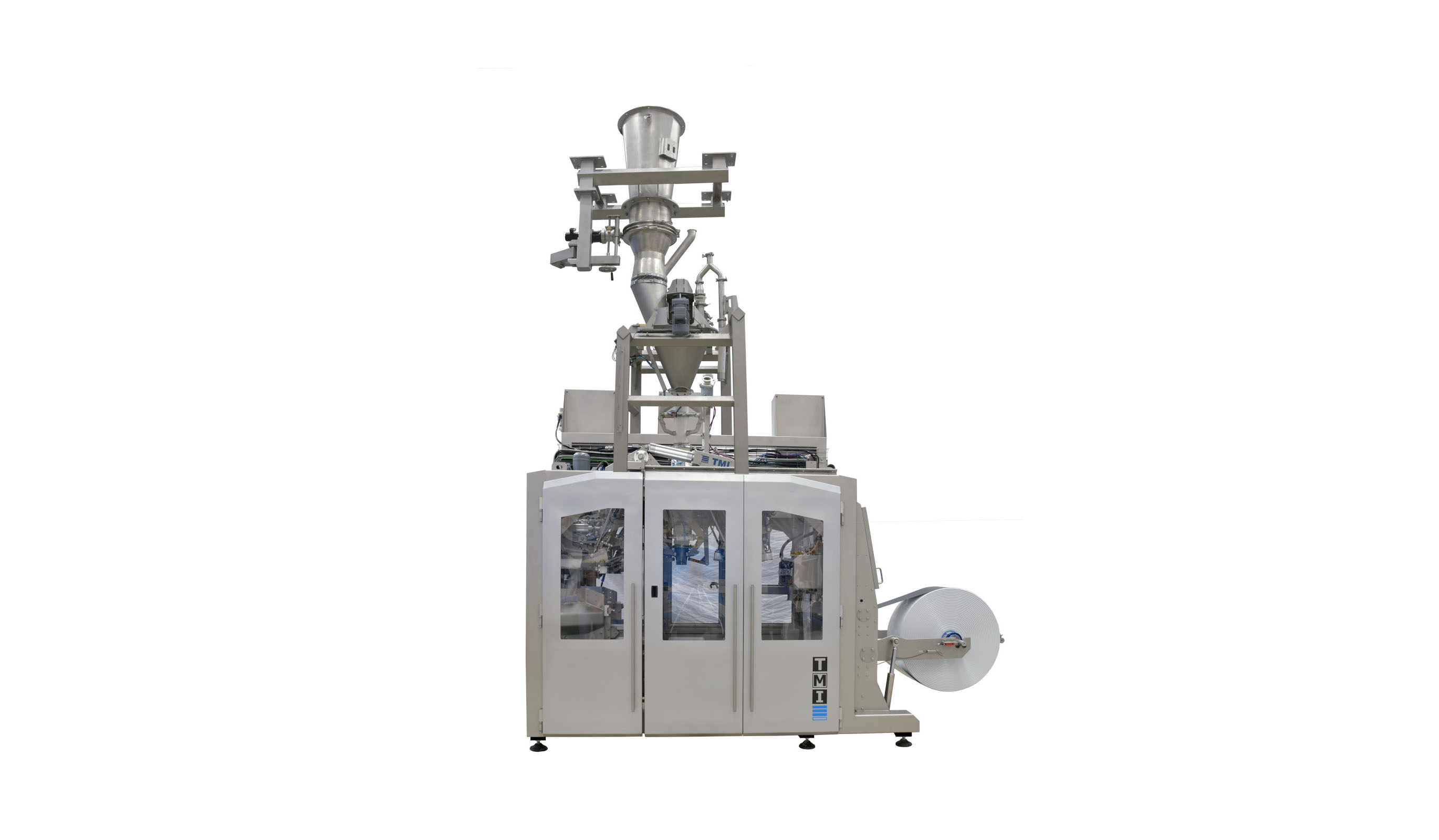
A technology company like TMI that develops solutions for so many different industries, will have to face from time to time a challenging project that, once taken, represents the opportunity for a quantum leap.
The experience and know-how that TMI has gained in the food industry, together with the previous experience of the customer, have led to developing a bagging machine that is highly accurate and efficient in the hygiene processes that are essential to food industry.
This was the challenge for TMI:
The customer needed a solution to bag an unstable hygroscopic product (sodium lactate) in 25kg bags for the food industry, which implied a strict washing routine. Additionally, the cost and market price of the product required a high dosing accuracy.
A crucial point was that powder release during bagging process had to be avoided at any costs and the structure had to be designed to prevent product accumulations.
The customer’s experience so far suggested that the continuous washing process needed to be improved in order to reduce the rusting, wearing and maintenance of the bagging equipment.
The customer had been bagging its product with HFFS system and wanted to continue using the same kind of technology. HFFS allows for a consumable standardisation while keeping the approved technical configuration of the bag, which protects the product from the air moisture.
The space for the machine had to be a small area, as the room to be placed needed to be completely climatized, thus saving climatization costs to the customer.
This is the solution by TMI:
Given this scenario, TMI has developed the ILERBAG HC: This special FFS bagging machine has been designed to be completely washable, tool-less operational, complying food-grade specifications and highly accurate and safe, while staying compact.
- Completely washable: The ILERBAG HC is fully water-resistant, indeed it has been completely constructed in Stainless Steel, as it must be washed thoroughly every end of cycle. To this scope a special water collection system has been designed to fit the bagging spout and connected to the customer’s drainage system. This contributes to prevent an increase of humidity in the room that could harm the conditioning of the room and with it the product itself. Additionally, several entrance points for conditioned air have been foreseen to dry the entire machine before the bagging process.
- Tool-less operation: The tool-less operation design of the dosing system guarantees accessibility and ease on the cleaning process. Its configuration with manual clamps allows the access all over the machine so that the operators can open each section easily by hand and clean it separately. Thus minimizing, on the one hand, the handling times and with it the cleaning changeover labour costs; and, on the other hand, the risk of dropping tools into the parts in contact with the product.
- Food-Grade Compliance: The ILERBAG HC has been fully designed to provide 200 filled and sealed bags per hour keeping a clean working environment. Product leakage has been minimized, whereas a supplementary aspiration system has been installed to prevent any powder to pollute the environment, for even more hygiene. Diamond shape design was used for construction of all structure elements, in order to avoid product accumulation on the machine’s surfaces. Additionally, the ground support points have been reduced to a strictly minimum, which makes the machine base and surroundings much more accessible for cleaning. Finally, the wiring has been prepared to leave all connections outside of the cleanroom, where the control cabinets are placed.
- Accurate and safe: Its dosing system consists on a Loss-weight scale with a vertical auger screw transport that assures the highest accuracy in the bagging process, while keeping the right output rhythm. A further benefit of this dosing system, in contrast to horizontal screw systems, is its small footprint. There is a double point metal detection system to ensure the safety of the bagged product.
The applications of ILERBAG HC
All these features make from ILERBAG HC a perfect machine to work in the food and the chemical industries where powdery products are produced. ILERBAG HC is suitable for those industries where a thorough cleaning and a dust-free environment are key for the proper operation of the plant. This compact solution is designed to suit small climatized or white rooms. Its tool-free configuration together with its high-accuracy contribute to increasing overall production efficiency in the bagging process, while saving a big amount of downtime implying a reduction of labour costs.
THE BENEFITS:
- Low Downtime: The opening and cleaning times are much faster thanks to its tool-free designs, reducing labour and saving significantly in cleaning costs alone.
- + Hygiene: Cleaning and maintenance processes have been made easier and faster. The configuration of the machine provides for a roast-free washing and drying routine.
- Dust-free environment: Air-tight joints throughout the dosing system together with aspirations avoid any product leaking, providing a clean environment.
- Small footprint: Very compact solution suitable for the most challenging layout configurations.
ONE BAGGING MACHINE, TWO DOSING SYSTEMS: FLEXIBILITY AND SAFETY IN FOOD PACKAGING PROCESSES
April 30, 2021
TMI's new solution enables two very different products to be bagged with a single FFS bagger with hygienic food grade design.
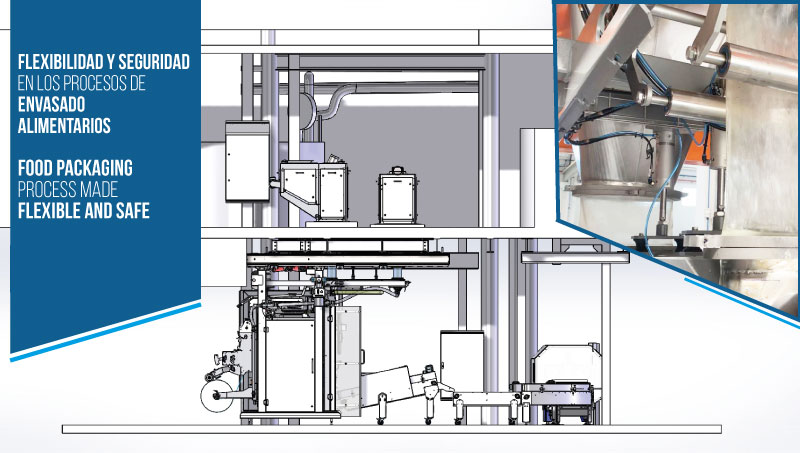
TMI has developed and manufactured a customised solution for a major international sugar producer that needed to bag two different products with very different performances. The in-depth knowledge of our product engineers, together with the customer's expertise, has allowed us to develop this solution for bagging two types of sugar using a single bagging machine.
The needs of the customer
The customer produces mainly two types of sugar: Soft Brown Sugar (SBS), which is highly mellow, adherent and difficult to handle, and Coarse Medium Sugar (CMS), which has a completely different behaviour and can be easily dosed by gravity.
Up to now, the customer was using a semi-automatic belt-weighing bagging machine, which was not specially designed for SBS. This generated a significant loss which at the end of the day would result in hundreds of kilos being stored in a reject bin. Therefore, one of the main goals was to reduce it.
The customer had assigned a limited space for this process automation project, which was too small to accommodate two bagging machines. Therefore, it required a single bagging machine that could handle both products.
A further important factor for the packaging of the two different products was the preservation conditions, which depended on the properties of each product: SBS requires an airtight vacuumized bag in order to preserve its properties for a longer period of time. CMS, on the other hand, requires breathable packaging to prevent the forming of clumps.
Because sugar is a food product, it requires a high level of hygiene. In this case, frequent water cleaning together with thorough drying of all parts in contact with the product were key to the design of the solution, which had to include food-grade finishes, such as parts in contact in AISI 304 stainless steel or FDA-certified.
And all this while maintaining a minimum nominal production of 7 bags/minute, and a maximum speed of 10 bags/minute in 20kg bags of FFS film.
The solution from TMI
TMI proposed the ILERBAG V flat film bagging machine to the customer, given the need to install an automatic bagging machine with FFS technology.
Having carried out the required tests in the TMI laboratory (ILERLAB), it soon became clear that this project required two different dosing systems: gravity and conveyor belt. This automatically opened the door to develop a bagging machine that could switch between the two dosing systems and which would allow:
- packaging 2 products with a single bagging machine,
- to use the minimum space necessary for packaging,
- to alternate filling and cleaning cycles,
- to pack hermetic or breathable bags, depending on the product.
These were the keys to the design of the ILERBAG VNGT:
MOVABLE BAGGING MACHINE
Easy and precise position switch: The ILERBAG VNGT shifts from one dosing system to the other by means of an upper rail system. It has three positions, enabling the bagging machine to be placed under each of the weighers and in a third position for maintenance.
Automatic connections: as soon as the machine is in position under one of the weighers, the connecting mechanism is activated by means of a pneumatic cylinder and flexible connections, the connector drops down, locks into position and automatically fastens onto the bagging machine.
HYGIENE
Quick and easy water cleaning: An automatic cleaning system with internal circulation and strategically placed sprayballs that apply hot water to all the internal surfaces of the dosing system. This water is evacuated by means of a watertight collecting system and is directed to the drainage point. This cycle is activated automatically by recipe and runs for 5 minutes. Finally, an air drying cycle is activated, preparing the surfaces to come in contact with the product.
Minimal floor support: Thanks to the upper guiding system, the bagging machine remains in contact with the floor only during bagging operations.
Minimised loss: A double scraper system optimises the packaging process by recovering the product stuck to the conveyor belt, which falls into the weighing bucket during filling. This minimises the wastage of product, which occurred with the previous system used by the customer.
FLEXIBILITY
For the packaging: The same bagging machine can be used to produce airtight bags for Soft Brown Sugar, and it can also perforate the bags with the integrated punching system.
For operation: While the ILERBAG VNGT is working under one of the two dosing systems, the cleaning cycle can be activated in the other, so that the overall operation and hygiene process is optimised.
EASE AND SAFETY OF OPERATION
Tool-free operation: Both dosing units are designed to be completely disassembled without the use of tools, likewise the reel change system, the forming tube and the punching device.
Safe position change: The position change is carried out using a pushbutton terminal with dead man's device, which ensures safety around the machine during movement.
Quick and safe connections: The harting connections ensure that the change of position of the bag exit conveyor belts can be carried out quickly and easily, with a quick connection of the wiring.

TMI Técnicas Mecánicas Ilerdenses SL in the framework of the ICEX Next Program, has been supported by ICEX and co-financed by the European ERDF fund. The purpose of this support is to contribute to the international development of the company and its environment.

TMI, en el marco del Ministerio de Industria y Turismo, ha desarrollado un proyecto titulado 'Implementación de mejoras integrales a los procesos, calidad y trazabilidad de TMI', subvencionado por dicho ministerio y financiado por la Unión Europea a través de Next Generation EU, en el marco de la convocatoria de apoyo financiero a planes de innovación y sostenibilidad en el ámbito de la industria manufacturera 2022.

Company
Industries
Services
Address
Polígono Industrial Camí dels Frares,
C/ Alcarràs, parc 66 - 25190 - Lleida · SPAIN Tel.
+34 973 25 70 98



